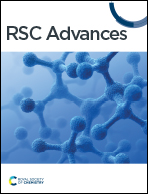Fischer–Helferich glycosidation mechanism of glucose to methyl glycosides over Al-based catalysts in alcoholic media†
Abstract
The Fischer–Helferich glycosidation reaction is generally the initial step in the conversion of glucose to levulinate in alcohol media. However, the relevant molecular mechanism catalyzed by Al-based catalysts is still not well understood. In this work, the reaction mechanism of the glycosidation from glucose to methyl glycosides catalyzed by Al3+ coordinated with methanol/methoxyl was investigated through density functional theory (DFT) calculations. The whole reaction process includes ring-opening, addition, and ring-closure events. The addition of methanol to the ring-opening structure of glucose makes the electronegativity of C1 site stronger to proceed with the following ring-closure reaction. Among the 28 kinds of ways of ring-closure reaction, the most preferred way is to close the loop through the six-membered ring (O5–C1) to generate methyl glucoside (MDGP). The rate-determining step is the ring-closure and the Al3+ shows a great catalytic effect which is mainly reflected in coordinating with the solvents to transfer protons. The results would be helpful to understanding the Fischer–Helferich glycosidation mechanism catalyzed by Al-based catalysts and comprehend the conversion of glucose to high value-added chemicals.



 Please wait while we load your content...
Please wait while we load your content...